Insights into capabilities and tools that help to win large deals profitably
In this article I will focus on two elements that help B2B companies increase win rates and prices on large deals: (1) value quantification and (2) mapping of B2B purchase criteria. I will first provide some context on pricing and on the role of large deals for B2B companies.
OfferdispersioninB2B–highlyconcentrated
Offers are typically concentrated in industrial markets. An analysis of the dispersion of offers and of invoice values provides the data: In recent projects with large, global B2B companies, my colleagues and I normally find that 4 to 10 percent of offers account for approximately 80 percent of the total annual offer value. Getting pricing right on the few large deals that truly matter is thus a fundamentally important activity to increase the overall performance of a firm.
Pricing–themostimportant,butfrequentlymostneglected,profitdriver
Pricing has a strong, but frequently underappreciated, effect on profits. A study of a sample of Fortune 500 companies suggests that the impact of pricing by far exceeds the impact of other elements of the marketing mix on profitability.1 An increase in average selling prices of 5 percent increases EBIT by 22 percent on average, while other activities, such as revenue growth or cost reduction, have a much smaller impact (exhibit 1).
Pricing is a very important contributor to company profits. It is frequently neglected, left in the hands of sales or account managers that lack the capabilities, tools and incentives required for profitable pricing.
Pricing is a very important contributor to company profits. It is frequently neglected, left in the hands of sales or account managers that lack the capabilities, tools and incentives required for profitable pricing.
Value quantification and the mapping of B2B purchase criteria are activities than help sales and account managers to identify price points that increase the likelihood of profit- ably winning large deals.
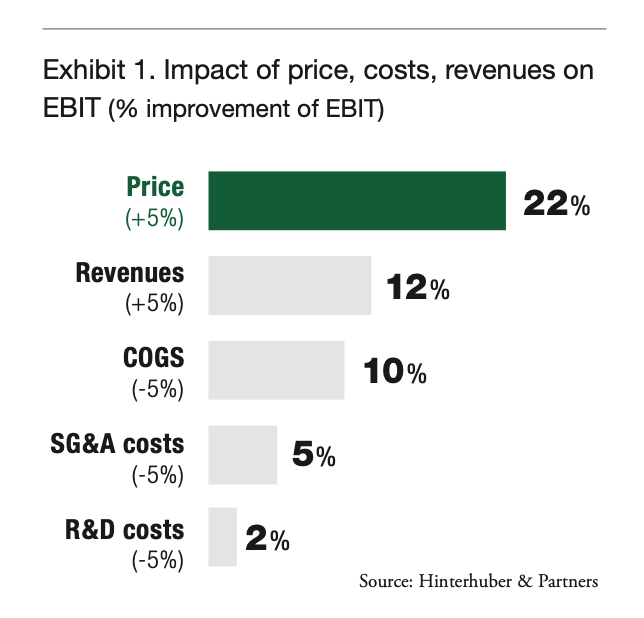
Value quantification – a key requirement for sellers in industrial markets
Buyer expectations towards SAMs and sales managers are changing2,3: In the past, selling was mainly about com- municating product benefits and features. This is no longer enough; today, SAMs and sales managers must document and quantify value to customers. A survey of 100 IT buyers at Fortune 1000 firms suggests that 81 percent of buyers expect vendors to quantify the financial value proposition of their solutions.4

Exhibit 2 provides the salient insights of this survey.
A subsequent survey asks 600 IT buy- ers about major shortcomings in their suppliers’ sales and marketing organiza- tions.5 These buyers see as important supplier weaknesses an inability to quantify the value proposition and an inability to clarify its business impact (see exhibit 3).
These surveys suggest the following:
(1) Sellers in industrial markets are expected to quantify value; (2) B2B buyers do not perceive that sellers are especially proficient in value quantiication. This leads to the question: Is value quantification beneficial in industrial markets? Do companies with superior value quantification capabilities outperform their peers? A recent empirical survey provides a very clear answer: The value quantifica- tion capability, i.e., the ability of SAMs and sales managers to translate a firm’s competitive advantages into quantified, monetary customer benefits, strongly improves the performance of a firm.3 Developing value quantification capa- bilities is thus a key differentiator for high-performing sales organizations.
Value quantification in practice
What is value quantification? Value quantification is about the ability to translate a firm’s competitive advantag- es into quantified, monetary customer benefits.3 Doing so requires translating both quantitative customer benefits — revenue/gross margin increases, cost reductions, risk reductions, and capital savings — and qualitative customer benefits — such as ease of doing busi- ness, customer relationships, industry experience, brand value, emotional ben- efits or other process benefits — into one monetary value equating total cus- tomer benefits received3. Whitepapers or quantified business cases are tools that leading B2B companies, includ- ing SKF, SAP, GE, Schneider Electric, Maersk, GE, Dell, Rockwell, 3M and others, use to quantify the value deliv- ered to customers. I will provide here a sanitized case study of a recent consult- ing project of Hinterhuber & Partners.
For a client in the intelligent traffic systems (ITS) industry, we quantified the financial value of intelligent, con- nected traffic display systems to system integrators – companies that purchase these and other products, bundle them with complementary products and sell a complete solution to city councils or highway operators. We conducted interviews with procurement managers.
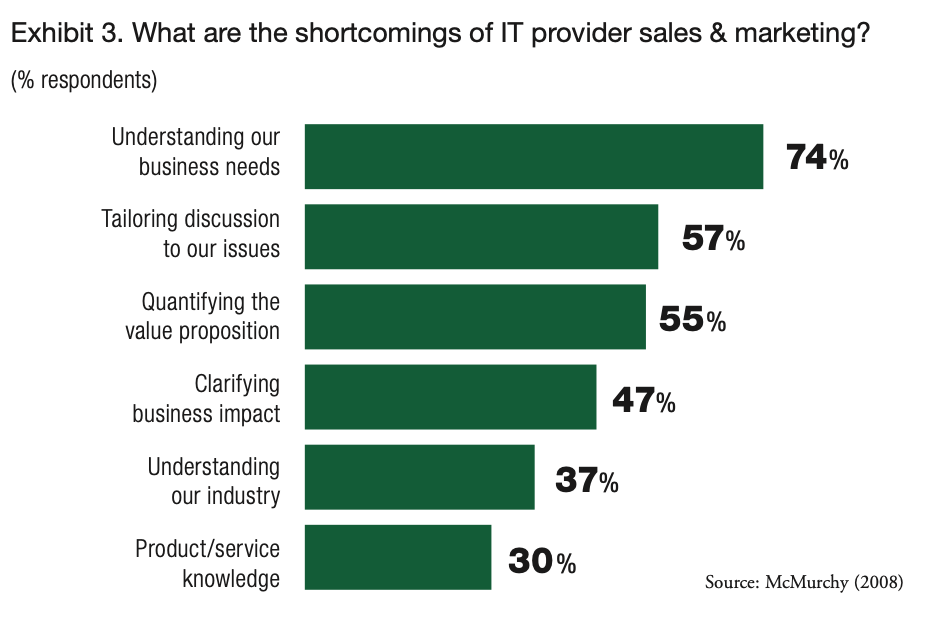
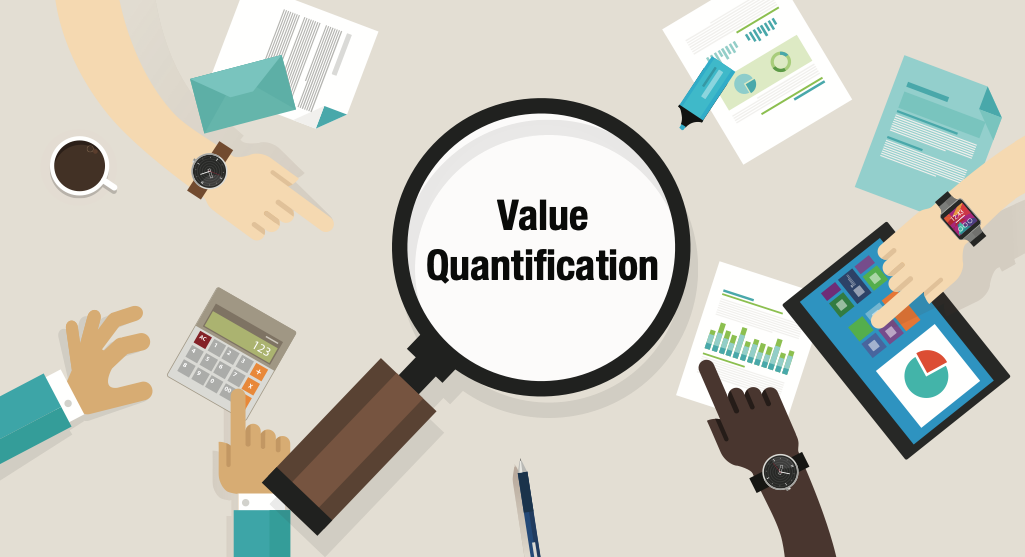
Value quantification is about the ability to translate a firm’s competitive advantages into quantified, monetary customer benefits.
To determine purchase criteria; we collected data from third parties on the performance of competitive traffic dis- play systems; we conducted workshops to validate preliminary findings; and we were able, after some further research, to determine the performance implica- tions of the competitive advantages of our client’s solution on their customers’ profitability.
Two key factors emerged that accounted for over 80 percent of the total quantified customer value. This process thus turned an initial long list of potential competitive advantages into two factors that sales, marketing and account managers could focus on in order to convey the financial benefits of their solution to B2B procurement managers. We used our proprietary tool, the Value Quantification Tool, to quantify the value of these differentiating factors and discovered that our client’s product delivered a very substantial amount of value vis-à-vis competitive solutions. This allowed us to determine, in a next step, a price that would allow sustained profitability to our client and an attrac- tive return on investment to the client’s customers. Exhibit 4 provides the result of this analysis.
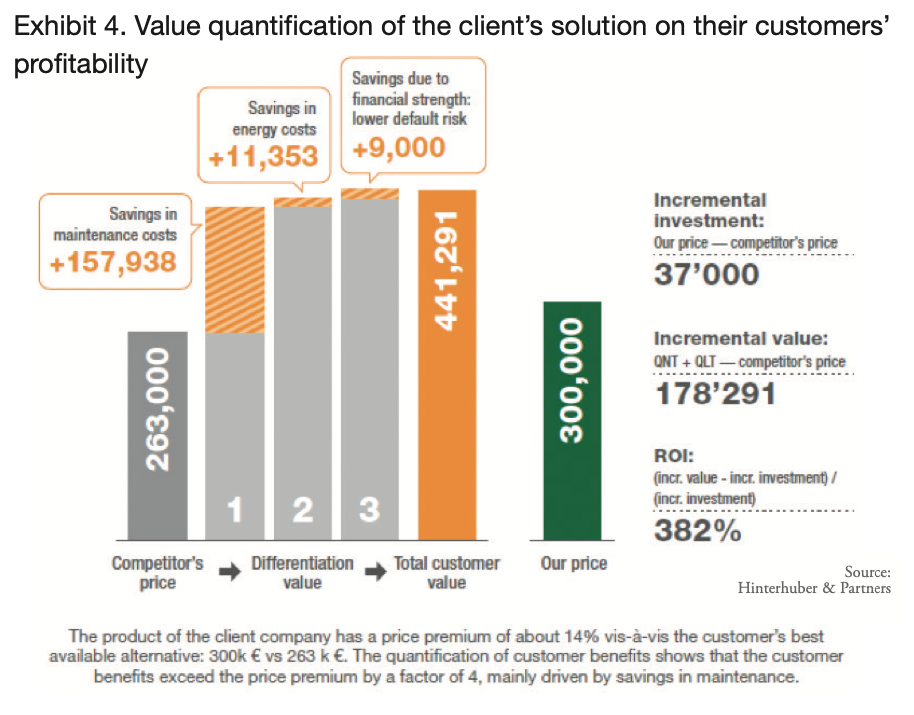
As a result of the process of value quantification, the price premium of the company’s product loses its negative connotation. The price premium of 14 percent is actually small compared to the return on investment of about 380 percent for customers purchasing the connected, intelligent traffic display systems.
Value quantification is therefore a very important process that allows procurement managers to put price in perspective; value quantification relates price differences to differences in monetary, customer-specific value. There is a catch: Since value quantification determines total quantified customer benefits, it identifies just the upper boundary of selling prices, but it cannot recommend a specific, profitvoptimizing, selling price.6 The process of value quantification thus leaves it to sellers to identify specific deal prices by taking into consideration other factors such as company goals (revenue versus profit maximization), customer price sensitivity, relative power vis-à-vis purchasers, competitive intensity and customer price perceptions.
The fact that value quantification pro- vides a range of prices instead of recom- mending a specific, profit-maximizing price point is usually not a limitation in those instances where sellers have the possibility to negotiate prices. Prices are adjusted in the negotiation based on new information – information on the weight of price vis-à-vis other criteria, or information on competitor price levels or product features. In a negotiated setting the process of value quantification can therefore help to win the deal by providing buyers compel- ling arguments on the business case of one supplier vis-à-vis a variety of other suppliers with apparently lower prices.
In competitive bidding situations there is usually no chance to renegotiate prices. There is one shot to get pricing right. The process of value quantifica- tion needs to be complemented with data on competitive offerings and data on customer purchase criteria. Two of the most prominent approaches pro- viding these insights are B2B purchase criteria mapping and bid-response functions. In this article we will focus on B2B purchase criteria mapping.7
Mapping B2B purchase criteria
Sales managers typically have an important weakness: “They do not listen,” says Bernard Quancard, presi- dent emeritus of SAMA.8 Numerous empirical studies in fact confirm that B2B buyers perceive their sales man- agers as lacking in listening skills. Understanding client business needs is in fact the most important shortcoming that IT buyers mention about sellers in the study cited previously (see exhibit 3). An earlier study similarly finds that a top complaint about sales managers is that they “do not listen.”9
Mapping B2B purchase criteria is a systematic process that aims to under- stand the importance and weight of B2B customer purchase criteria and the relative performance of alternative sup- pliers on these criteria in order to deter- mine a selling price that maximizes the chances of winning the deal. Mapping B2B purchase criteria of course requires understanding them in the first place.
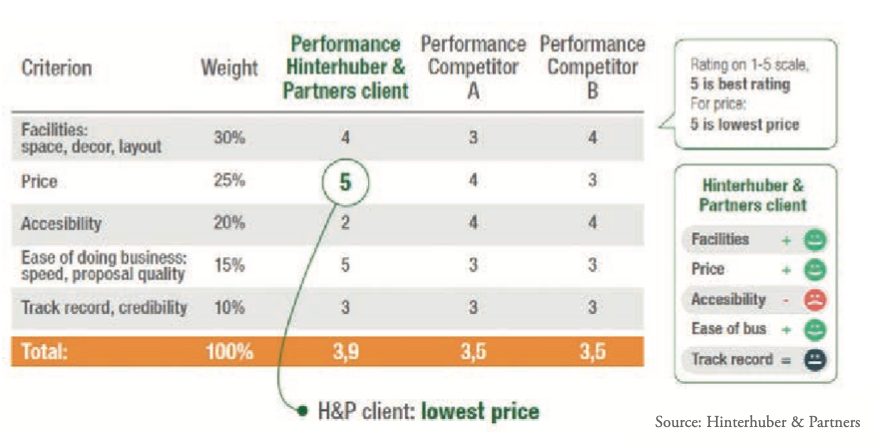
One way to map B2B purchase criteria is to use a matrix that B2B procurement organizations frequently use in order to evaluate alternative suppliers. Exhibit 5 provides an example.
This matrix requires two main inputs: (1) an understanding of B2B customer purchase criteria and (2) insights into the firm’s own performance and the per- formance of key competitors on these purchase criteria. Sales and account managers should rank and weigh these criteria: For public tenders the criteria are, this is clear, published; sales man- agers should measure the performance of their own company and the perfor- mance of two to three key competitors on the purchase criteria. They should of course take the perspective of the specific procurement organization that is evaluating the bid. Data sources are customer interviews, customer surveys or third-party data on performance in actual field conditions.
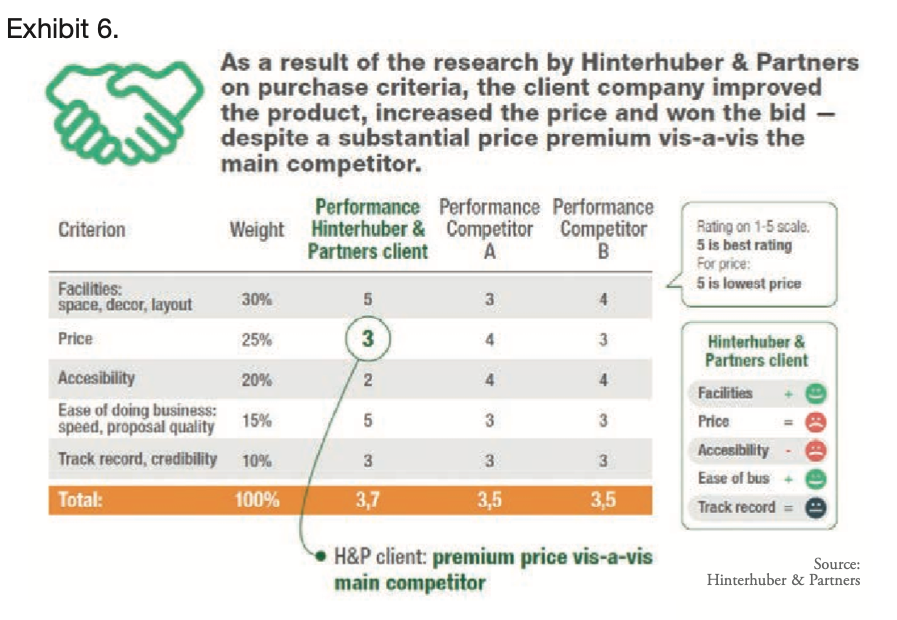

The pricing sweet spot is thus low enough to win the deal and high enough to do so profitably.
The example, also from a recent consulting project of Hinterhuber & Partners, illustrates how our client ini- tially attempted to win the bid. Client management at first suggested to bid below key competitors in order to achieve the highest score on the supplier evaluation matrix. Our research helped the client to win the deal at a price premium vis-à-vis the main competitor. First, the research uncovered purchase criteria. Next, we measured customer- perceived performance and objective performance against these criteria. We also identified ways to differentiate the client’s offering further from key competitors along the most important purchase criteria. (See exhibit 6 for details.) The research provided insights into unmet customer needs that helped to differentiate the product and create a truly distinctive offer. Mapping of purchase criteria on the matrix led to the conclusion that the client had a reasonably high chance of winning the bid at a premium price vis-à-vis the main com- petitor. This turned out to be the case.
Putting the idea to practice
Pricing has an imme- diate, substantial impact on profitability. Pricing is not easy. Pricing too low leads to low profits, pricing too high leads to low revenues. The pric- ing sweet spot is thus low enough to win the deal and high enough to do so profitably. In very simple terms, this article highlights the importance of one key fac- tor in winning large deals profitably: preparation
Preparation wins deals, as opposed to an escalation involving ever more senior management levels depend- ing on deal size. Value quantification translates competitive advantages into customer-specific economic benefits and thus identifies the upper boundary of selling prices. B2B purchase crite- ria mapping plugs a specific, profit- optimizing selling price into a matrix comparing the overall attractiveness of alternative offers in order to understand the likelihood of winning the deal at any given price.
Winning the next big deal profitably is the ambition of every SAM, every account manager and every CEO. Big deals are few: Value quantification and B2B purchase criteria mapping can help to identify the sweet spot of pricing that identifies profitable price points that win the next big deal.
References
1 Hinterhuber, A. (2004). Towards value-based pricing—an integrative framework for decision making. Industrial Marketing Management, 33(8), 765-778.
2 Hinterhuber, A. (2017a). Value quantification – processes and best practices to document
and quantify value in B2B. In A. Hinterhuber & T. Snelgrove (Eds.), Value first, then price: Quantifying value in business markets from the perspective of both buyers and sellers (pp. 61-74). Milton Park, UK.: Routledge.
3 Hinterhuber, A. (2017b). Value quantification capabilities in industrial markets. Journal of Business Research, 76, 163-178.
4 Ernst & Young. (2002). Fortune 1000 IT buyer survey: What could shorten sales cycles and further increase win rates for technology vendors? Economics & Business Analytics white paper.
5 McMurchy, N. (2008). Tough times in IT: How do you exploit the opportunities? Gartner presentation.
6Nagle, T., Hogan, J., & Zale, J. (2011). The strategy and tactics of pricing: A guide to growing more profitably (5th ed.). Upper Saddle River, NJ. : Prentice Hall.
7 Phillips, R. (2005). Pricing and revenue optimization. Stanford, CA. : Stanford University Press.
8 Hinterhuber, A., Snelgrove, T., & Quancard,
B. (2017). Interview: Nurturing value quantification capabilities in strategic account managers. In A. Hinterhuber & T. Snelgrove (Eds.), Value first, then price: Quantifying value in business markets from the perspective of both buyers and sellers (pp. 39-48). Milton Park, UK. : Routledge.
9 HR Chally Group. (2002). Ten year research report. Dayton, OH.



